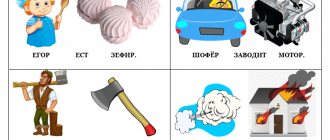Hissing sounds: where to start staging
We show the child a card with the sound Ш, draw a phoneme, explain how the tongue is located: now it is at the top, the edges are pressed tightly against the molars. Instead of the phrase “sound Ш” it is better to say “warm wind”, “snake hisses”, “inflate the balloon”.
Articulatory gymnastics for staging hissing (exercises by L.A. Komarova)
- “Cup”
- the mouth is open. Raise a wide, relaxed tongue to the upper lip. Bend the middle part of the tongue and bend the side edges upward. It turns out to be a cup. We take the “cup” inside and take it back out. Do this several times. - “Horse”
- “glue” the tongue to the palate. Thus, the hyoid frenulum is stretched. The lower jaw remains motionless. With a click, we “unstick” the tongue - the “horse” clicks. - “Fungus”
- “glue” the tongue to the palate, open the mouth wide. Hold this position for several seconds. - “Accordion”
- make a “mushroom”. Only now we open and close our mouth, stretching the hyoid frenulum. Keep your tongue “glued” to the palate, lips in a smile. - “Swing”
- mouth wide open. Stretch your tongue either to your nose or to your chin. - “Donut”
– mouth slightly open, lips extended slightly forward and rounded.
“Let’s warm our palms” - imagine that your hands are frozen in the cold. Open your mouth, stretch your lips forward, exhale “x-x-x”, warming your palms.
The exercises that are performed when setting C, “Punish a naughty tongue”, “Spatula”, “Candy”, “Jam”, “Brushing teeth” are repeated when setting Sh. You don’t need to do everything, choose 5-7 of any articulation exercises, and also remember about the development of the air stream.
Ways to make the sound Ш
In front of the mirror, we ask the baby to blow a cold wind onto his palm. Now invite the child to “cup” his tongue by the upper teeth onto the alveoli and try to say “ssss” again. In this position of the tongue you will hear “sh-sh-sh”. If it doesn’t work out, you can hold the roll stick between your teeth (your tongue should lie on the stick, not under it) and blow. Or use a clean finger to hold your tongue up. It is important to explain to the baby that the wide tongue should be behind the upper teeth - then “the snake will hiss.”
After successful consolidation of Ш, we obtain the sound Ж in the same way as the phoneme Z. We place our palm on the throat and ask the child to compare hissing and buzzing: “sh-sh-sh” - the throat is calm, “zh-zh” - the throat is trembling.
To get H, ask your baby to say a soft "t'-t'-t'" and gently move his tongue slightly deeper into the mouth using a spoon/q-tip/clean finger. The sound SH should appear automatically. We fix each phoneme according to the scheme, teach the child not to confuse whistling and hissing. For this purpose, learning poems where both types of sounds are found, and games for differentiating phonemes are suitable.
10 books for automating sounds
- “Speech therapist lessons. Correction of speech disorders”, N.S. Zhukova.
- “Album of a preschooler. Automation of sounds in game exercises”, L.A. Komarova.
- “We learn sounds. Home speech therapy notebook for children 5-7 years old,” E.A. Azova, O.O. Chernova.
- “We pronounce the sounds correctly. Speech therapy album for children 4-8 years old,” T.A. Tkachenko.
- “Home notebook for speech therapy sessions with children”, Yu.B. Zhikhareva-Norkina.
- “Games with paired cards. Speech therapy board games for children 5-7 years old”, Z.T. Bobyleva.
- “I speak correctly”, didactic material by O.E. Thunderous.
- “We are speaking correctly. Games for speech development”, E.M. Kuritsyna, L.A. Taraeva.
- “Album for automating sound pronunciation”, O.I. Lazarenko.
- “Speech therapy album. We speak correctly,” T.S. Reznichenko, O.D. Larina
Setting the sound K
1. By imitation (if there is no sound). Simulation of a pistol shot.
2. Setting K from the anterior lingual T using a spatula, probe or other available means.
The child says TA-TA-TA. The speech therapist presses with a spatula (probe) on the front part of the back of the tongue, moving approximately 1 cm. It turns out something like this: TA-TYA-KYA-KA.
In some cases, I simply use a finger wrapped in sterile gauze or a clean handkerchief and push the back of the tongue back.
3. From the correct articulatory structure formed with the help of gymnastics. The tip of the tongue is at the lower gums, the back of the back of the tongue is pressed tightly to the palate. Add a strong, sharp short exhalation.
Exercises for pronouncing sounds
Initially, it is recommended to prepare cards that will depict animals and objects that have problematic letters at the beginning, middle or end. You need to observe whether the pronunciation of a complex letter always turns out to be problematic, or in some positions.
1. To master the letter “C”, it is recommended to use the following exercises:
- “Rails” (when the tongue must “ride” along the inside of the upper teeth).
- “Silence” (repeat the sound “t-sss” several times, stretching the letter “S”).
To reinforce the letter, you need to choose pictures or words where the letter “C” is present: sleigh, sieve, belt, sun, light. You can use sentences: Sasha sows seeds or poems:
"It's dark in the forest,
Everyone has been sleeping for a long time.
One owl doesn't sleep
She’s sitting on a branch.”
2. The letter “Z” is a brother of “S”, only voiced. Therefore, to teach a child to pronounce the letter “Z”, you need to pronounce “s” only by raising your voice. Show your baby by raising your hand to his throat how the muscles tense, making ringing sounds. We fix the letter with words: hare, animal, tooth, star, as well as sentences: A bunny in winter is like a small animal.
3. The letter “C” can be mastered by resorting to the “Silence” exercise, only you need to pronounce not “t-sss”, but “ts-ts-ts”. We fix it with words: heron, chicken, chain, pizza, and sentences: What color is the bird?
4. You can pronounce the letter “Ш” using a little trick: ask the child to pronounce the letter “s”, and use a spoon to lift the baby’s tongue to the sky. The sound will be “sh”. The letter is fixed with the words: awl, whisper, ears, noise; sentences: Our Masha rustles; and also in verse:
“Dear bear, Nice bear, Our bear is all made of plush.”
5. The same trick can be done with the letters “z” and “z”. fix the letter “F” with the words: beetle, hedgehog, toad. And also in sentences: Zhanna is waiting for a book.
6. To master the letter “Ch” , ask your baby to say “t-t-t” while pressing the baby’s cheeks with your fingers. Then you will hear the cherished “h”. To reinforce the letter, ask your child to say the words: tea, turtle, daughter, ball; suggestions: Clean the siskin's bathtub.
7. The most common problem for parents is the problem of the letters “R” and “L”. Techniques and exercises for solving this problem are aimed at teaching the child to growl without swallowing complex letters and without replacing the complex “r” with the easier “l”:
“Horse” - together with your child, imitate the clicking and clattering of a horse’s hooves.
“Brush your teeth with your tongue” - ask your baby to smile widely. Then you need to run your tongue along the inner surface of the upper teeth. Make sure that the child's lower jaw remains motionless.
“Tease” - the child is invited to tease. To do this, the relaxed tongue sticks out and dangles up and down. The teasing is accompanied by a growl.
Special attention in teaching the letters “P” or “L” is paid to tongue twisters:
- The Greek was driving across the river, he saw the Greek: there was cancer in the river.
- There is grass in the yard, there is firewood on the grass: one, two, three there is firewood.
- The brave man ate thirty-three pies, all of them with cottage cheese.
- You can’t say all the tongue twisters quickly.
Teaching a child to pronounce sounds
There are many different techniques for correct speech production of a baby. But many parents do not know how to teach their child to pronounce letters at home, and therefore immediately turn to speech therapists for help. Although this problem can often be solved at home. You just need to approach the organization of classes correctly. Parents should remember that they should not overload the baby; the duration of each lesson should not exceed 15 minutes. If the child shows reluctance to study, postpone the lessons for a while. By forcing a child to pronounce letters by force, you can forever discourage him from speaking correctly and learning in general.
Before each lesson, it is necessary to sit the child down, making sure that he sits upright. All distracting objects are removed, the TV is turned off. An excellent option would be to practice in front of a mirror so that the child can see not only the articulation of the adult sitting in front of him, but also his own.
In phrases
Say phrases, clearly pronouncing “x”: cotton robe, boastful khan, long-haired chameleon, boorish character, bad move, good housewife, hobbit campaign, artist’s canvas, cold ear, worst find, deaf healer, quiet laughter, resourceful foot soldier, dry moss , the rooster died, breathe in the air, the monk's staff.
In a playful way, invite your child to match the masculine words with the corresponding feminine ones:
- penguin - penguin;
- rabbit - female rabbit;
- giraffe - giraffe;
- elk - moose cow;
- seal - female seal;
- hippopotamus - hippopotamus;
- doctor - doctor;
- cook - cook;
- catcher - catcher;
- weaver - weaver.
Why do children’s tongues “don’t like” simple sounds?
Mostly 3-year-old children have difficulties with the sounds G (gammacism), K (kappacism) and X (chitism). Children either replace these sounds, for example, K with T, G with D, X with T, or do not pronounce them at all and skip them. This phenomenon occurs due to the structural features of the palate, the insufficiently active root of the tongue (hypotonicity), or the baby is simply too lazy to make an effort and pronounce the sound correctly.
It is extremely important to recognize and overcome diction deficiencies at an early stage, when the articulatory apparatus is still developing. In kindergarten, speech therapists deal with this problem, but parents also need to help the child overcome the speech defect. For this, there are excellent, and most importantly, effective exercises, games, and gymnastics, developed by practicing doctors “on speech.”
Reasons why a child may not pronounce letters
Incorrect pronunciation of letters may be due to improper upbringing. If parents, when communicating with their child, change their voice, lisp or babble, then the baby gets used to such communication and his incorrect pronunciation of letters is reinforced.
Therefore, you need to speak to your child in correct and clear language. Immediately stop the slightest shortcomings in your baby’s speech, because with age it will be several times more difficult to correct them.
Wrong attitude towards spoken language. There is an opinion that learning to speak occurs without intervention from adults. But if parents do not participate in the process of developing the child’s speech, then over time the child’s lag in speech development will begin to appear.
Secrets to help quickly teach your child to pronounce letters
In addition to direct exercises with the child’s speech muscles and exercises to teach complex letters, it is necessary to pay attention to the development of fine motor skills. Together with your child, sort out the cereals, string beads on a string, and sculpt them from plasticine or dough. And most importantly: while working, do not be silent. Tell your child fairy tales, nursery rhymes or tongue twisters.
Another secret is to teach your child to repeat the letter “D” often. By pronouncing this magic letter, the muscles of the tongue are trained, it is positioned correctly in the mouth, and with constant training, the child will learn to pronounce the complex letter “r”.
In sentences
Invite your child to complete the phrases with the words “shepherd” or “turtle”:
- herds sheep (shepherd);
- chews a leaf (turtle);
- wakes up early;
- hid in her shell;
- working in the meadow;
- carries his house on himself;
- Lena draws;
- runs after the cows.
Practice pronouncing sentences:
- cotton robe;
- the reckless driver rushes over potholes;
- there was still gunpowder left in the flask;
- The beaver has valuable fur;
- The buffoon jumped the highest;
- there are thistles growing in the yard;
- there is soft moss in the swamp;
- peas are sown in the beds;
- the monk forgot his staff;
- the meadow has dried up;
- I want halva;
- the chess player made a bad move;
- you go hiking;
- the rooster flapped his wings;
- Genghis Khan is a cunning khan;
- Petya boasts of his good eyesight;
- the artist’s canvas is empty;
- fish soup was cooked over the fire;
- the cunning fox is hunting.








